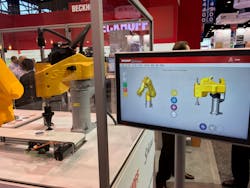IoT Integration is the Next Technological Innovation
The International Manufacturing Technology Show always brings the biggest manufacturing crowd in North America. This year’s show saw record-breaking numbers, boasting an attendance of 129,415, 2,563 exhibiting companies, and 2,123 booths. The previous attendance record was set in 1998 with 121,764, making this the largest IMTS in more than a decade.
A large part of that audience was due to the Hannover Messe USA show held in its own building, spanning two floors. Hannover Messe being at IMTS brings another level of automation and technology to the show; IMTS’ largest focus has been on machining and tooling. Large companies like Mazak, with its expertise in tooling equipment, draw in a large machinery crowd. However, with Hannover Messe USA expanding its footprint at the crowd, companies like Siemens and Beckhoff have brought the Internet of Things (IoT) crowd, and you can see it permeate every industry at IMTS.
Connected devices, integrated sensing, and data analytics are now tools or services that every company offers regardless of its field of industry. Machinists now offer CNC machines with vibration sensing for predictive maintenance; companies like igus offer their e-chain cables with built-in sensors; and automation companies are using collaborative robots, like Universal Robots, on top of mobile robots, like the MiR Platform, to create mobile cobots. Individually, none of these products are new, but the integration of these products to create a technological ecosystem is, and its starting to skyrocket.
Within the last few years, my show experience has mainly consisted of visiting companies talking to me about the wonders to come in the world of IoT. That world has always been one about a connected system and, at first, the focus was heavy on data and sensors. IoT was a way to implement this data gathering network to improve systems and establish a new communication layer to transfer data. Now, IoT is allowing us to connect not just via data but also through systems. Sensors and instant connectivity with the use of Ethernet is allowing for any device—whether it be a PLC or an advanced autonomous robot—to connect to the same network and communicate with each other.
The next stage, in my opinion, is artificial intelligence integration. Now that different types of machines are integrated with IoT and can work with each other, we need a smart intelligence system to communicate our desires to these complicated networks. Having integrated AI that can decipher our wishes into the proper machine code will enable automated systems to work faster and more efficient.

